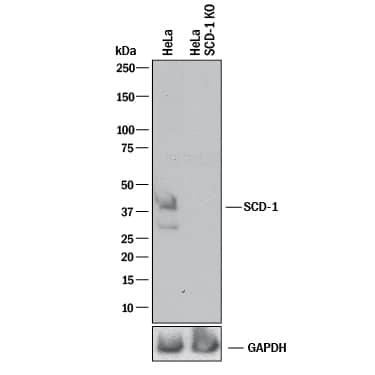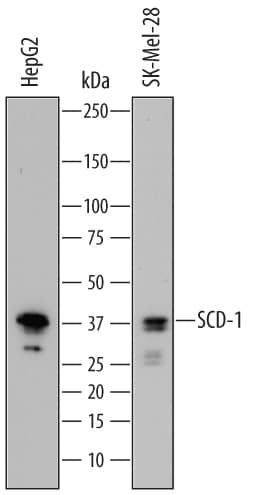Human SCD-1 Antibody
R&D Systems, part of Bio-Techne | Catalog # AF7550

Key Product Details
Validated by
Species Reactivity
Validated:
Cited:
Applications
Validated:
Cited:
Label
Antibody Source
Product Specifications
Immunogen
Ala141-Gly221
Accession # O00767
Specificity
Clonality
Host
Isotype
Scientific Data Images for Human SCD-1 Antibody
Detection of Human SCD‑1 by Western Blot.
Western blot shows lysates of HepG2 human hepatocellular carcinoma cell line and SK-Mel-28 human malignant melanoma cell line. PVDF membrane was probed with 0.5 µg/mL of Sheep Anti-Human SCD-1 Antigen Affinity-purified Polyclonal Antibody (Catalog # AF7550) followed by HRP-conjugated Anti-Sheep IgG Secondary Antibody (HAF016). A specific band was detected for SCD-1 at approximately 38 kDa (as indicated). This experiment was conducted under reducing conditions and using Immunoblot Buffer Group 1.Western Blot Shows Human SCD‑1 Specificity by Using Knockout Cell Line.
Western blot shows lysates of HeLa human cervical epithelial carcinoma parental cell line and SCD-1 knockout HeLa cell line (KO). PVDF membrane was probed with 0.5 µg/mL of Sheep Anti-Human SCD-1 Antigen Affinity-purified Polyclonal Antibody (Catalog # AF7550) followed by HRP-conjugated Anti-Sheep IgG Secondary Antibody (HAF016). A specific band was detected for SCD-1 at approximately 41 kDa (as indicated) in the parental HeLa cell line, but is not detectable in knockout HeLa cell line. GAPDH (AF5718) is shown as a loading control. This experiment was conducted under reducing conditions and using Immunoblot Buffer Group 1.Western Blot Shows Human SCD-1 Specificity Using Knockout Cell Line.
Western blot shows lysates of HeLa human cervical epithelial carcinoma parental cell line and SCD-1 knockout HeLa cell line (KO). Nitrocellulose membrane was probed with 1 µg/mL of Sheep Anti-Human SCD-1 Antigen Affinity-purified Polyclonal Antibody (Catalog # AF7550) followed by HRP-conjugated anti-sheep IgG Secondary Antibody. A specific band was detected for SCD-1 at approximately 36 kDa (as indicated) in the parental HeLa cell line, but is not detectable in knockout HeLa cell line. The Ponceau stained transfer of the blot is shown. This experiment was conducted under reducing conditions. Image, protocol, and testing courtesy of YCharOS Inc. See ycharos.com for additional details.Applications for Human SCD-1 Antibody
Immunoprecipitation
Sample: Cell lysate of HeLa human cervical epithelial carcinoma cell line
Knockout Validated
Western Blot
Sample: HepG2 human hepatocellular carcinoma cell line and SK‑Mel‑28 human malignant melanoma cell line
Reviewed Applications
Read 1 review rated 5 using AF7550 in the following applications:
Formulation, Preparation, and Storage
Purification
Reconstitution
Formulation
*Small pack size (-SP) is supplied either lyophilized or as a 0.2 µm filtered solution in PBS.
Shipping
Stability & Storage
- 12 months from date of receipt, -20 to -70 °C as supplied.
- 1 month, 2 to 8 °C under sterile conditions after reconstitution.
- 6 months, -20 to -70 °C under sterile conditions after reconstitution.
Background: SCD-1
SCD-1 (Stearoyl-CoA desaturase 1; also Acyl-CoA desaturase, fatty acid desaturase, and Delta-9 desaturase) is a 37-40 kDa member of the fatty acid desaturase family of enzymes. It is an ER-embedded protein that is expressed by multiple cell types, including adipocytes, hepatocytes, macrophages, endothelial and sebaceous gland cells. SCD-1 catalyzes the formation of monounsaturated fatty acids from saturated fatty acids. It does so by generating a double bond between the C9 and C10 carbons of dietary and/or endogenously synthesized fatty acids. This creates either palmitoleic or oleic acid, two fatty acids that are optimally suited for either storage or inclusion into phospholipids. It also removes a potential source of inflammation, as saturated fatty acids are known to activate TLRs with the subsequent onset of inflammation. Human SCD-1 is a 4-transmembrane (TM), 359 amino acid (aa) protein. It contains a 71 aa cytoplasmic N-terminus, followed by two TM segments (aa 72-119) and an extended cytoplasmic region (aa 120-216) that possesses three utilized Ser/Thr phosphorylation sites, two additional TM segments (aa 217-273), and a C-terminal cytoplasmic tail (aa 274-359) that contains most of the catalytic region. There is one potential isoform variant that shows a 13 aa substitution for aa 295-359. Over aa 141-221, human SCD-1 shares 95% aa sequence identity with mouse SCD-1.
Long Name
Alternate Names
Gene Symbol
UniProt
Additional SCD-1 Products
Product Documents for Human SCD-1 Antibody
Product Specific Notices for Human SCD-1 Antibody
For research use only




